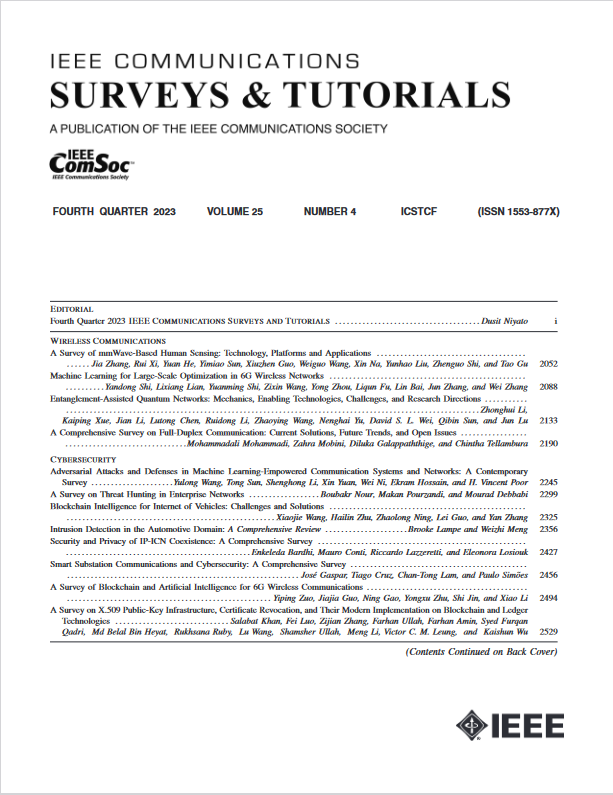CrowdTransfer: Enabling Crowd Knowledge Transfer in AIoT Community
IF 34.4
1区 计算机科学
Q1 COMPUTER SCIENCE, INFORMATION SYSTEMS
引用次数: 0
Abstract
Artificial Intelligence of Things (AIoT) is an emerging frontier based on the deep fusion of Internet of Things (IoT) and Artificial Intelligence (AI) technologies. The fundamental goal of AIoT is to establish a self-organizing, self-learning, self-adaptive, and continuous-evolving AIoT system by orchestrating intelligent connections among Humans, Machines, and IoT devices. Although advanced deep learning techniques enhance the efficient data processing and intelligent analysis of complex IoT data, they still suffer from notable challenges when deployed to practical AIoT applications, such as constrained resources, dynamic environments, and diverse task requirements. Knowledge transfer, a popular and promising area in machine learning, is an effective method to enhance learning performance by avoiding the exorbitant costs associated with data recollection and model retraining. Notably, although there are already some valuable and impressive surveys on transfer learning, these surveys introduce approaches in a relatively isolated way and lack the recent advances of various knowledge transfer techniques for AIoT field. This survey endeavors to introduce a new concept of knowledge transfer, referred to as Crowd Knowledge Transfer (CrowdTransfer), which aims to transfer prior knowledge learned from a crowd of agents to reduce the training cost and as well as improve the performance of the model in real-world complicated scenarios. Particularly, we present four transfer modes from the perspective of crowd intelligence, including derivation, sharing, evolution and fusion modes. Building upon conventional transfer learning methods, we further delve into advanced crowd knowledge transfer models from three perspectives for various AIoT applications: intra-agent knowledge transfer, centralized inter-agent knowledge transfer, and decentralized inter-agent knowledge transfer. Furthermore, we explore some applications of AIoT areas, such as human activity recognition, urban computing, multi-robot system, and smart factory. Finally, we discuss the open issues and outline future research directions of knowledge transfer in AIoT community.CrowdTransfer:在 AIoT 社区实现人群知识转移
物联网人工智能(AIoT)是基于物联网(IoT)和人工智能(AI)技术深度融合的新兴前沿领域。人工智能物联网的根本目标是通过协调人、机器和物联网设备之间的智能连接,建立一个自组织、自学习、自适应和持续发展的人工智能物联网系统。尽管先进的深度学习技术增强了高效的数据处理和复杂物联网数据的智能分析,但在部署到实际的物联网应用中时,它们仍然面临着显著的挑战,例如资源受限、动态环境和多样化的任务要求。知识转移是机器学习中一个很受欢迎和有前途的领域,它是一种有效的方法,可以通过避免与数据回忆和模型再训练相关的过高成本来提高学习性能。值得注意的是,尽管已经有一些关于迁移学习的有价值和令人印象深刻的调查,但这些调查以相对孤立的方式介绍了方法,缺乏AIoT领域各种知识迁移技术的最新进展。本研究试图引入一个新的知识转移概念,即群体知识转移(Crowd knowledge transfer, CrowdTransfer),它旨在转移从一群智能体中学习到的先验知识,以降低训练成本,并提高模型在现实复杂场景中的性能。特别地,我们从群体智能的角度提出了四种传递模式,包括衍生模式、共享模式、进化模式和融合模式。在传统迁移学习方法的基础上,我们进一步从三个角度深入研究了先进的群体知识转移模型,用于各种AIoT应用:智能体内部知识转移、集中式智能体间知识转移和分散式智能体间知识转移。此外,我们还探讨了AIoT在人类活动识别、城市计算、多机器人系统和智能工厂等领域的应用。最后,讨论了AIoT领域知识转移研究中存在的问题,并对未来的研究方向进行了展望。
本文章由计算机程序翻译,如有差异,请以英文原文为准。
求助全文
约1分钟内获得全文
求助全文
来源期刊

IEEE Communications Surveys and Tutorials
COMPUTER SCIENCE, INFORMATION SYSTEMS-TELECOMMUNICATIONS
CiteScore
80.20
自引率
2.50%
发文量
84
审稿时长
6 months
期刊介绍:
IEEE Communications Surveys & Tutorials is an online journal published by the IEEE Communications Society for tutorials and surveys covering all aspects of the communications field. Telecommunications technology is progressing at a rapid pace, and the IEEE Communications Society is committed to providing researchers and other professionals the information and tools to stay abreast. IEEE Communications Surveys and Tutorials focuses on integrating and adding understanding to the existing literature on communications, putting results in context. Whether searching for in-depth information about a familiar area or an introduction into a new area, IEEE Communications Surveys & Tutorials aims to be the premier source of peer-reviewed, comprehensive tutorials and surveys, and pointers to further sources. IEEE Communications Surveys & Tutorials publishes only articles exclusively written for IEEE Communications Surveys & Tutorials and go through a rigorous review process before their publication in the quarterly issues.
A tutorial article in the IEEE Communications Surveys & Tutorials should be designed to help the reader to become familiar with and learn something specific about a chosen topic. In contrast, the term survey, as applied here, is defined to mean a survey of the literature. A survey article in IEEE Communications Surveys & Tutorials should provide a comprehensive review of developments in a selected area, covering its development from its inception to its current state and beyond, and illustrating its development through liberal citations from the literature. Both tutorials and surveys should be tutorial in nature and should be written in a style comprehensible to readers outside the specialty of the article.
 求助内容:
求助内容: 应助结果提醒方式:
应助结果提醒方式:


